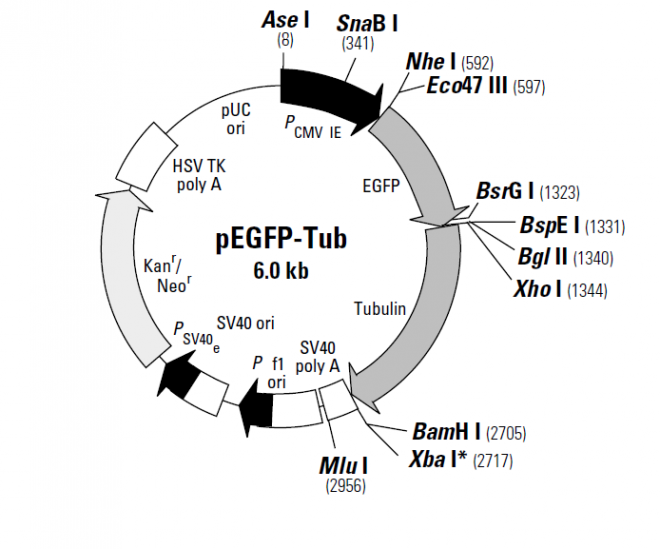pEGFP-Tub 载体
| 质粒类型: | 荧光蛋白报告载体 |
|---|---|
| 启动子: | CMV |
| 克隆方法: | 多克隆位点,限制性内切酶 |
| 载体大小: | 6045 bp (查看载体序列) |
| 载体标签: | EGFP |
| 载体抗性: | Kanamycin (卡那霉素) |
| 筛选标记: | Neomycin (新霉素) |
pEGFP-Tub encodes a fusion protein consisting of the red-shifted, human codon-optimized variant of green fluorescent protein (EGFP; 1–3) and the gene encoding human α-tubulin (4, 5). EGFP, a derivative of the GFPmut1 variant (6), has been optimized for brighter fluorescence and higher expression in mammalian cells. (Excitation maximum = 488 nm; emission maximum = 507 nm.) This variant contains the double-amino-acid substitution of Phe-64 to Leu and Ser-65 to Thr, as well as more than 190 silent base changes that correspond to human codon-usage preferences (7). SV40 polyadenylation signals downstream of the EGFP-Tub fusion direct proper processing of the 3' end of the mRNA. The vector backbone also contains an SV40 origin for replication in mammalian cells expressing the SV40 T-antigen. A neomycin resistance cassette (Neor), consisting of the SV40 early promoter, the neomycin/kanamycin resistance gene of Tn5, and polyadenylation signals from the herpes simplex virus thymidine kinase (HSV-TK) gene, allow stably transfected eukaryotic cells to be selected using G418. A bacterial promoter upstream of this cassette drives expression of the gene encoding kanamycin resistance in E. coli. The pEGFP-Tub backbone also provides a pUC origin of replication for propagation in E. coli and an f1 origin for single-stranded DNA production.
载体应用
The pEGFP-Tub Vector is designed for expressing the EGFP-tubulin fusion protein in mammalian cells. The protein incorporates directly into microtubules and thereby allows the observation of microtubules in living or fixed cells by fluorescence microscopy (5, 8). pEGFP-Tub can be transfected into mammalian cells using any standard transfection method. If required, stable transformants can be selected using G418 (9).


